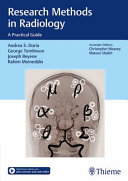

Most ebook files are in PDF format, so you can easily read them using various software such as Foxit Reader or directly on the Google Chrome browser.
Some ebook files are released by publishers in other formats such as .awz, .mobi, .epub, .fb2, etc. You may need to install specific software to read these formats on mobile/PC, such as Calibre.
Please read the tutorial at this link: https://ebookbell.com/faq
We offer FREE conversion to the popular formats you request; however, this may take some time. Therefore, right after payment, please email us, and we will try to provide the service as quickly as possible.
For some exceptional file formats or broken links (if any), please refrain from opening any disputes. Instead, email us first, and we will try to assist within a maximum of 6 hours.
EbookBell Team

4.1
70 reviewsResearch Methods in Radiology provides concise, practical insights on how to design clinical and experimental studies in diagnostic imaging. This unique resource encompasses contributions from leaders in academic radiology as well as top epidemiologists, biostatisticians, and librarians with vast multidisciplinary and radiology research experience. The material reflects years of expertise teaching core biostatistics in radiology principles to residents, fellows, radiologists, and epidemiologists.
Given the vast amount of published information on research methodology and statistics in radiology, the authors' goal was to write a high-yield review and study tool rather than a comprehensive book. Key topics are succinctly addressed in each chapter, including measurements in radiology; decision analysis in radiology; and systemic reviews, evidence-based imaging, and knowledge translation. Online exercises related to each topic enable residents to prepare for radiology board examinations and research radiologists to apply knowledge to clinical studies.
Key Highlights
Introductory chapters on analysis of diagnostic tests, linear and logistic regression, meta-analysis, statistical inference, and economic evaluation provide easy-to-follow tutorials
Each chapter includes learning objectives, basic concepts, supplementary tables, and ancillary online material
Case studies with images, graphs, and tables highlight primary "take home" points
Sample size calculations are illustrated for a wide range of research questions
Code is included for use in R, free open-source software for statistical analysis
This book is an indispensable review of research methodology for radiology students and residents. Practicing clinicians will also benefit from this precisely focused reference tool on clinical and experimental research.